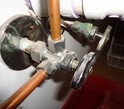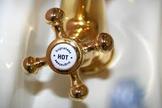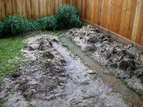|
The most often-asked question is, "How often should I pump my septic tank?" Typically, new homeowners unfamiliar with septic systems must learn how to manage them to avoid expensive complications. Although a septic system is a safe, natural, and ecologically beneficial approach to handling domestic drain waste, it differs from a sewer system and needs specific care and upkeep.
Septic tank pumping should be performed at the appropriate intervals for your residence.Although some broad standards state that a septic system should be pumped every 2-5 years, the fact is that you should pump your plan as frequently as your system requires. The amount of sludge and scum in the tank determines how often a septic tank should be drained. Your septic system uses the natural strength of gravity to split domestic wastewater into three parts:
Usually, the sludge and scum stay in the septic tank while the watery mixture drains into the drain field. But, to keep things running well, the septic tank's sludge and scum must be cleansed regularly. If the sludge level increases to unsafe levels and the scum level thickens, the sludge or scum will be driven out of the drain field with the watery effluent. Pushing particles and grease down the drain field may clog the subterranean perforated pipe system, resulting in sluggish drains and even wastewater backups into your house. This may result in harmful germs in your home and a costly repair. Most homes that pump more often than required are overpaying!By pumping too often, there isn't enough sludge and scum buildup in the tank to provide the best return on investment in septic tank pumping expenditures. Like any other routine maintenance, paying for the service more often than necessary is a good use of money with no added advantages. The fact is that your septic system needs a certain quantity of beneficial bacteria to function properly. Like the human digestive system, the septic tank employs anaerobic digestion to break down waste for the next step of filtration naturally. Although pumping at the proper intervals is essential, it does diminish biomass levels, and it may take up to 1-3 weeks for your septic system to restore to healthy bacteria levels. When you flush the toilet with organic waste material, the bacteria enter your tank and break it into sludge and effluent. If you over-pump your septic tank, germs will have nowhere to go except out into the drain field, causing blockages and failures. Hence, leaving the septic tank alone is advantageous until your septic tank's sludge and scum levels exceed specified criteria. This maintains the proper bacterial balance to keep your system running normally. So, how will you know how often to pump your septic tank?As you can see, your septic tank's sludge and scum levels are the two most important elements in determining your timetable. When the sludge level at the bottom of the tank reaches 1 foot or the scum at the top is almost 6 inches thick, it's time to drain your septic tank. Contrary to common assumption, most homes do not need yearly pumping. It depends entirely on your tank levels rather than a particular time range. You may check the stories yourself, or we can measure and record them for you as a simple and mess-free solution. How to Determine If Your Septic Tank Is FilledThen, find and gently remove the septic tank cover. Take extra care to prevent the heavy lid from cracking or breaking, and never leave the open tank alone! The tank holds 4-5 feet of subsurface water and may be harmful if a person or a pet falls in. The next step is to inspect the scum trap at the top to see how thick the scum layer is. You should generally pump your septic tank when the scum level reaches 6 inches wide. The second, more complicated procedure is to measure the amount of sludge at the tank's bottom. Although you may buy a sludge-level measurement stick, you can also create your own. Just take a seven-foot sturdy post or two by four and wrap an 18-24 inch velcro strip around it, beginning at one end. The velcro end will be the one that goes into the tank. Holding the measuring stick upright, slowly drop the velcro end of the post straight into the septic tank, even through the thick sludge at the bottom, until you feel the stick touch the tank's base. Afterward, straighten the measuring rod and inspect the velcro strip. Since the black, thick sludge will adhere to the velcro, you can estimate how many inches of sludge are at the bottom depending on the length of the strip on the stick. We suggest the septic tank be flushed when the sludge level exceeds 1 foot (12 inches). Although a homeowner may do this themselves, most prefer our simple inspection service to measure and calculate your home's maintenance plan. Unlike many other septic service businesses, Elizabeth Drain Service will utilize picture documentation to show you precisely where your waste levels are and help you monitor how long it takes for your scum and sludge levels to build up to the proper limits. We'll create a tailored septic tank pumping plan based on your household's data so you can maintain your system functioning correctly without spending money on unnecessary maintenance.
0 Comments
Leave a Reply. |
Archives
March 2024
Categories
All
|
- Plumbers / Drain Service
-
Plumbing Services
- Boiler Repair - Replace
- Clogged Drains and Sewer Lines
- Faucet Replacement
- Elizabeth Furnace Installation & Replacement
- Furnace Service & Maintenance
- General Plumbing Repairs
- Heat Pump Service & Maintenance
- Hot Water Heater Repair Replace
- Humidity Control & Dehumidification
- New Supply and Drain Lines
- Toilet and Vanity Replacement
- About Us
- Privacy Policy
- Contact Us
-
Areas We Service
- Plumber Bayonne
- Plumber Belleville
- Plumber Carlstadt
- Plumber Edgewater
- Plumber Hoboken
- Plumber Jersey City
- Plumber Kearny
- Plumber Lodi
- Plumber Lyndhurst
- Plumber Newark
- Plumber North Arlington
- Plumber North Bergen
- Plumber Palisades Park
- Plumber Ridgefield Park
- Plumber Rutherford
- Plumber Secaucus
- Plumber Teaneck
- Plumber Union City
- Plumber West New York
- Plumber Weehawken
- Blog
|
Elizabeth Plumbers and Drain Service

162 Elmora Ave. #323
Elizabeth, NJ 07202 elizabethdrainservice@gmail.com www.elizabethdrainservice.com (908) 988-0365 |
Elizabeth Drain Service is a full service and licensed plumbing contractor that specializes in drain clearing and sewer backups and repairs. Call us today if you have any plumbing needs.
|

 RSS Feed
RSS Feed



